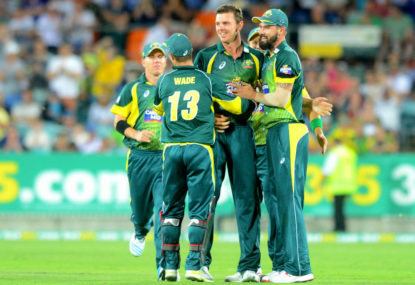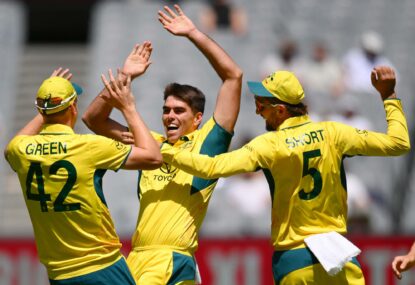After Australia and South Africa left Perth with the One Day series tied at one game apiece, they headed to Canberra’s Manuka Oval, home of the famous Manukan Wave, for the third game. Here’s how everything of importance in the match rated.
Canberra
Grade: B-
The Australian selectors brought Kane Richardson, Xavier Doherty and Mitchell Starc into the team, leaving out Mitchell Johnson (rested), Nathan Coulter-Nile (missed the plane?) and Glenn Maxwell (reverse-selected).
Obviously, the decision to not play excitement machine Maxwell was based upon Canberra’s infamous reputation for boringness, which seems grossly unfair.
This pitch, like all cricket pitches, was perfectly designed for a Maxwellian late order cameo of 29 (19) before being caught switch-hitting to, oh, let’s say long on. Surely Canberran cricket fans could have handled such an innings without bursting into a rioting rabble like a bunch of delirious six-year-olds on a crazed sugar high.
Alas, we’ll never know. Sorry, Canberra.
Powerplay Timing
Grade: C+
There have been various forms of powerplays over the years. Mandatory powerplays. Batting powerplays. Bowling powerplays. There was also even a time when powerplays were simply called ‘the first fifteen overs’, if you can possibly imagine an era of such lacklustre branding.
In the powerplay’s current form, the batting team has massive flexibility, with the option to take their five overs at any time between the 10th and 36th over. Despite this, batting captains invariably leave the taking of the powerplay as late as possible. Presumably this is in the hope that the umpires will forget to enforce it, since this ostensible advantage to the batting team almost always leads to wickets and a resurgence for the fielding team.
But with the Australian openers motoring along at 0/113 after 19 overs, the Australians opted to abandon tradition and take the powerplay early. It was a strategic move, upsetting the South African bowling plans and forcing them to bowl their best bowlers when they’d been planning to sneak in their part-timers. It also gave David Warner and Aaron Finch many more gaps in the outfield that they could exploit, now that they were seeing the ball well. It all made perfect logical and tactical sense.
Of course, it failed terribly. Warner was dismissed almost immediately and new batsman Shane Watson spent the rest of the five overs seeing himself in.
Still, on the plus side, it did give commentators something to talk about other than the pungency of Brett Lee’s kebab. So, overall, a good thing.
Faf du Plessis’s Fielding
Grade: B+
Despite the failure of The Great Powerplay Timeshift, Australia’s innings otherwise proceeded without incident. Runs were made. Wickets fell. George Bailey struggled for timing. You know the drill. With 49 overs having been bowled, Steve Smith had smashed his way to 60 off 50 balls, with the total on 5/310.
During that final over, Smith launched a ball well over the rope for what would have been a six, if not for Faf du Plessis spectacularly leaping from inside the field and parrying the ball back to one of his fellow fielders.
This was impressive, sure, but he didn’t land in an esky, as Smith himself had managed to do while boundary fielding in the UAE last month. So du Plessis changed tack and instead tried to trump Smith by taking an outstanding sliding one-handed catch millimetres off the ground. But the catch was off a no ball, and Smith followed up by caressing the free hit between his legs for four.
Luckily, the over and innings ended before this senseless game of one-upmanship between the pair could get any sillier. Australia had set South Africa 330 to win. That was silly enough, surely.
DRS
Grade: B-
At one point, the 330 run chase didn’t look silly at all, but instead breathtakingly run of the mill. This was when Australia carelessly allowed Hashim Amla and AB de Villiers to bat together and they responded by putting on a partnership of 76 off 56 balls.
It all seemed too easy for the pair until Richardson, who’d otherwise done very little all night, trapped de Villiers LBW. The captain immediately reviewed the very plumb decision, based on the South African guiding principle that if a decision against de Villiers is overturned, the opposition team will almost certainly instantly forfeit the game. (I mean, imagine it. Against all odds, you somehow get him out, and then get told that he’s going to get another chance. You’d just want to sit down and cry.)
Fortunately for Australia, the decision wasn’t overturned. And when Amla was out in the next over, it was only a matter of time until Australia won. And since time – showing once again its hatred of all things South African – continued to march on at its standard rate, Australia did, indeed, win, taking a 2-1 lead in the series.
Australian Fast Bowlers
Grade: A
Starc and Josh Hazlewood impressed with their bowling. Earlier in the series, Coulter-Nile had taken a five-fer. Pat Cummins had also bowled well in the T20s. Meanwhile, in the Sheffield Shield, both Ryan Harris and Peter Siddle had taken plenty of wickets.
Would it be so crazy to select all of them for the First Test and have a team of Warner, Maxwell (wk), Smith (c), Johnson, Starc, Cummins, Coulter-Nile, Siddle, Harris, Hazlewood and Nathan Lyon?
Of course it would be, but it’d be funny too, right?





































































































